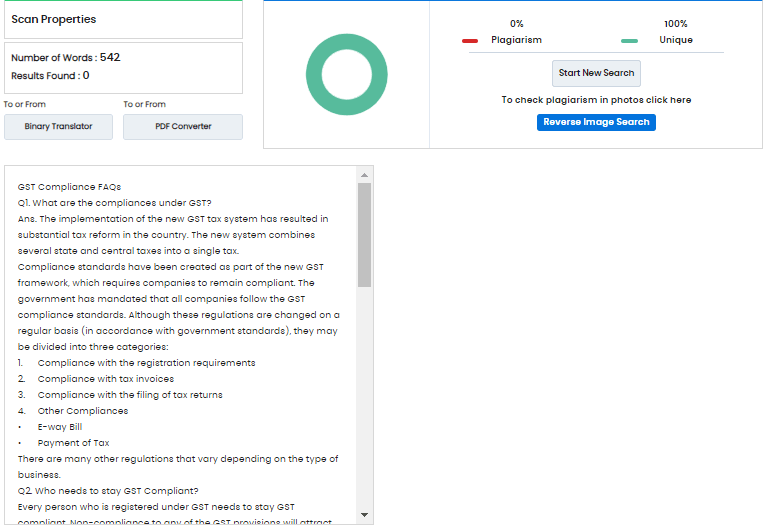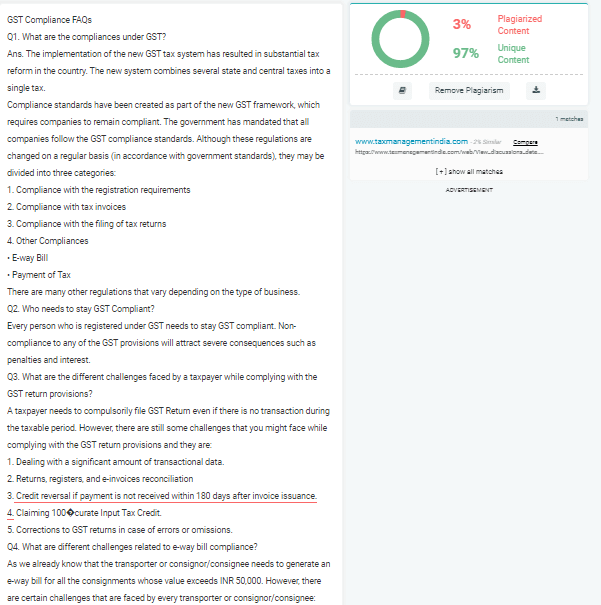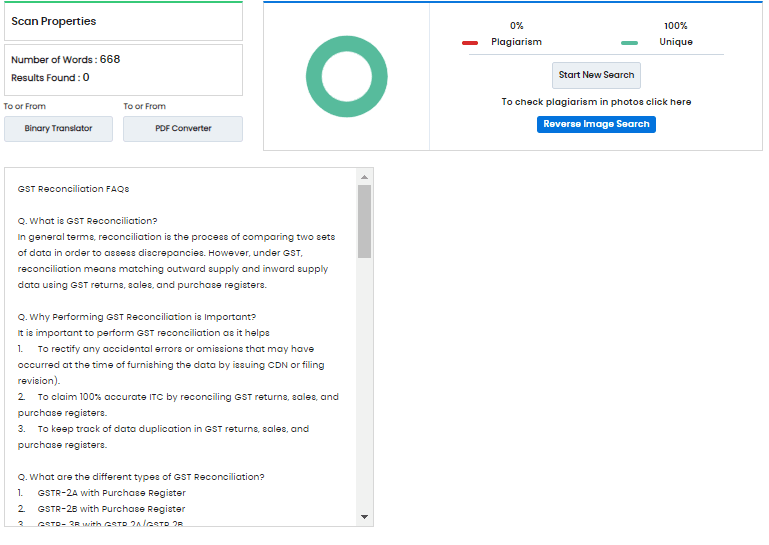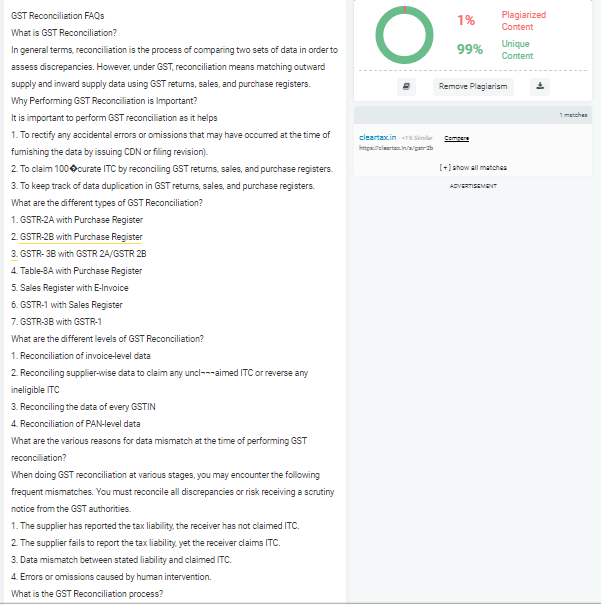
E-invoicing or electronic invoicing is the system where the invoice is prepared as per the schema or format prescribed in rule 48(4) of CGST rules (Form GST INV-01) is uploaded on the Invoice Registration Portal (IRP) to obtain Invoice Reference Number (IRN).
Note: e-Invoicing does not mean generation invoices on a government portal.
No, the process of invoice generation will remain the same under the newly introduced e-invoicing system.
E-invoicing Process:
Note: A GST invoice will be considered authentic only with a valid IRN.
Currently, only those taxpayer whose aggregate turnover exceeds INR 500 Crores turnover in any FY 2017-18, 2018-19, 2019-20 or PAN based needs to compulsorily generate e-invoices.
After various date extension, the council decided to make e-invoicing mandatory for the notified classes from 1st October 2020. However, the government decided to provide some relaxations for 30 days such as waving of interest and penalty for late IRN generation considering the problem faced by taxpayers amid the coronavirus outbreak.
Here is the list of benefits of e-invoice for businesses:
To be e-invoicing ready, a business needs to either take an e-invoicing software or API from us (GSTrobo). This software or API will help you to create, report the invoices to IRP and obtain IRN, and QR code in a few clicks using your existing ERPs or accounting/billing software.
Currently, the following documents and transactions are covered under the new e-invoicing system:
Currently, under the new e-invoicing system, e-invoices need to be generated for Business to Business (B2B) supplies, export supplies including deemed export supplies and SEZ supplies.
No, the e-invoicing provision does not apply to B2C supplies. It is only applicable to B2B and export supplies.
No, currently, e-invoicing provision is not applicable to import supplies.
There are multiple modes available for the notified class of taxpayer using which they can generate e-invoices:
Here is the list of entitiess that are exempted from the e-invoicing mandate:
The government has facilitated free offline utility using which invoices can be easily generated and reported to Invoice Registration Portal to obtain IRN along with signed QR code.
No, IRN can only be obtained by the supplier by reporting the generated invoices to IRP. The supplier cannot directly generate IRN.
Yes, the user can bulk upload the invoices to Invoice Registration Portal (IRP). Howsoever, Invoice Reference Number (IRN) for the uploaded invoices will be assigned one by one. But for the taxpayer, the system will show bulk upload and bulk receipt.
No, it is not possible to store or archive e-invoices on IRP. However, the data of the uploaded invoice remains in the IRP for 24 hours.
In general ‘Schema’ means a structured format or template. Similarly ‘e-invoice’ schema means the standard format set by the Government. The notified e-invoice schema is ‘Form GST INV-01.’
Schema ensures that the e-invoice generated is inter-operable and machine-readable. In simple language, schema ensures that the invoice level data can easily be understood and processed by different ERPs such as NAVISION, Oracle, SAP, and so forth.
E-invoice format is based on PEPPOL or Universal Business Language (UBL).
There is only one type of schema that is applicable to different types of businesses. To cater to the needs of different businesses there are different optional fields.
Invoice has to be reported to IRP in JavaScript Object Notation (JSON) format. In layman terms, it is a language using which systems/machines communicate with each other and exchange data.
There are 2 main fields that are present in the e-invoice schema:
IRN and Invoice numbers are two different concepts. The invoice number is assigned by the supplier and the format can differ too. On the contrary, IRN is a unique number assigned by the IRP and the format of the same remains the same irrespective of the type of business.
IRN is unique code which has 64 character Hash. Let us take an example to understand how it looks like.
46079dd24c67021kfc24f49ec4444dbab81f542c555f9d4549dc69794e06ccd
Yes, Invoice Registration Portal (IRP) can reject an Invoice, if the data mentioned in the invoice already exist in the GST system and certain other validations.
Note: IRP upon rejecting will show relevant error codes.
Invoice Registration Portal will not return any PDF only the signed JSON will be returned.
However, the user can generate the PDF of the JSON file using his ERP or Accounting and Billing software, if needed.
Once the IRP registers an invoice, the supplier will receive a signed JSON file with IRN and QR codes.
Yes, one can easily print an e-invoice. But to print the same, he/she would need to convert the JSON format into PDF.
No, there is no such compulsion to print IRN on the invoice. IRN is already there in the QR Code that has to be there on an invoice.
The JSON file of the invoice received from the IRP will contain the QR code in a string (not image). The ERP or accounting and billing need to then convert this string into a QR code image for placing it on the invoice.
Yes, it is necessary to print the QR code on the invoice as it will act as a sign of authenticity.
No, there is as such no obligation to issue copies of the invoice in triplicate or duplicate.
Yes, the parties involved in the transaction can download and save the registered invoices on handheld devices. It shall be noted that this can be done through GST System and not the IRP.
Under the new e-invoicing system, Invoice Registration Portal (IRP) will itself generate the QR Code. Moreover, the QR Code will contain all the important information related to an e-invoice, such as:
Yes, there can be more than one QR code on an invoice apart from the QR code containing IRN. It shall be noted that the different QR codes must be placed in such a way that it can be distinguished easily from the QR code consisting of IRN.
Yes, a user can cancel an invoice registered on IRP using the Cancel API that too within 24 hours of generation of IRN.
No, a user cannot use the invoice number of the e-invoice canceled. Moreover, if you use the same invoice number it will get rejected by the IRP.
Yes, the details of a reported invoice can be amended on the GST portal and not on IRP. Further, while amending an invoice you need to keep the relevant provisions of GST Law and Rules in mind.
Yes, the invoice level data (commonly known as payload) will be auto-pushed to the GST system. Moreover, GSTR-1 of the supplier will get auto-populated too.
Yes, the invoice level data (commonly known as payload) will be auto-pushed to the e-way bill system. In case if the details of both the Part-A and Part-B of the e-way bill is there in the e-invoice, the e-way bill gets auto-generated. In case if the Part-B is not present, the user needs to fill the same on the e-way bill system to generate the e-way bill.
E-invoicing (Electronic Invoicing) is an electronic system of invoice authentication under GST. Under this e-invoicing system, all the taxpayer dealing in B2B, and Export supplies and whose turnover exceeds INR 500 Crore Marks needs to generate an e-invoice through Invoice Registration Portal (IRP).
The general mandatory field for generating an e-invoice is:
A taxpayer can easily acquire the IRN from IRP using any one method from the following two options:
The Invoice Registration Portal will generate a signed QR code containing the hash (IRN) along with some important data so that it can be verified by an Offline App.
The size of the QR code will depend upon the space available on the invoice. However, the typical size of the printed signed QR code is 2 X 2 inches.
Note: The size of the QR code should be easily readable from the QR code scanners.
Under the new e-invoicing system, the QR Code will be used to provide a quick overview of the generated invoice. Moreover, the QR code will also help tax officers that are out on the field to verify whether a particular invoice is valid and contains all the relevant information.
E-Way Bill is an electronic way bill generated for the movement of goods where value of consignment is more than Rs. 50000. E-Way Bill has 2 components Part A containing details of consigner and consignee, delivery address, invoice number and date, HSN code, amount and value of goods, and Part B –comprising of transportation details transport document number and Vehicle number in case of road.
The E-Way Bill can be generated through multiple modes such as GSTrobo, a GSP (Goods and Services Tax Suvidha Provider) using GSTrobo Mobile Application, site to site integration via GSTrobo E-Way Bill APIs and using SMS based facility.
Part A details can be furnished to obtain a Temporary E-Way Bill Number. Validity of E-Way Bill begins only when Part B details are updated in case of road and a Permanent E-Way Bill Number is obtained. Temporary E-Way Bill number is valid for 15 days for first time update of Part-B.
If multiple consignments are intended to be transported in one conveyance, E-Way Bill Numbers generated in respect of each consignment can be added in a consolidated E-Way Bill. A consolidated E-Way Bill number can be provided in case of interception of goods.
In case where some of the consignments being transported are of value less than 50,000 and some are of value greater than 50,000. Then the user can generate E-Way Bills and Consolidated E-Way Bill for only consignments of value greater than 50,000 or for all of the consignments.
Consignor or supplier can provide his own GSTIN in transporter Id.
In such cases, the supplier or consigner shall issue the complete invoice before dispatch of the first consignment and must issue a delivery challan for each of the subsequent consignments, giving reference of the invoice. An E-Way Bill must be generated against each delivery challan. Each consignment must be accompanied by original delivery challan, a copy of invoice and a E-Way Bill number. The last consignment must be accompanied by original copy of invoice.
Yes. It needs to be issued in other cases as well involving the movement of goods such as to job-work, replacement under warranty, recipient not known, supply of liquid gas where quantity is not known, supply returns, exhibition or fairs, for own use, Sale on approval basis and others etc.
Yes, Validity of E-Way Bill can be extended. This can be done 8 hours before and after expiry of the validity of E-Way Bill.
The Part-B or transportation details can be updated as many times as one wants to update for the movement of goods until the E-Way Bill is valid. The details furnished in Part-B must always be true during the movement of goods. The validity of E-Way Bill is not re-calculated for subsequent entries in Part-B.
The information furnished in the Part-A of E-Way Bill on GSTrobo’s E-Way Bill Application shall be made available to the registered supplier on GSTrobo’s GST Application who may utilize the same for furnishing details in GSTR-1.
If multiple consignments are intended to be transported in one conveyance, E-Way Bill Numbers generated in respect of each consignment can be added in a consolidated E-Way Bill. A consolidated E-Way Bill number can be provided in case of interception of goods.
In case where some of the consignments being transported are of value less than 50,000 and some are of value greater than 50,000. Then the user can generate E-Way Bills and Consolidated E-Way Bill for only consignments of value greater than 50,000 or for all of the consignments.
E-Way Bill validity can be increased and the vehicle number can be updated.
The Vehicle Number must be entered in any one of the below format in the E-Way Bill Part B:
Consolidated E-Way Bill is a document containing the multiple E-Way Bills for multiple consignments being carried in one conveyance (goods vehicle). That is, the transporter,carrying multiple consignments of various consignors and consignees in one vehicle can generate and carry one consolidated E-Way Bill instead of carrying multiple E-Way Bills for those consignments.
Goods and Services Tax (GST) is an indirect tax that has replaced existing 17 taxes, such as VAT, Octroi, Sales Tax, Service Tax, and Excise Duty, and so forth. Under GST the state in which goods or/and services are consumed receives the revenue unlike the old tax structure, where the state of origin received tax revenue.
Central taxes subsumed under GST:
State taxes subsumed under GST:
The ‘supply’ of goods or services or both from registered person to any person or entity in India triggers GST.
Supply means any
There are 3 components of GST
Export is considered to be Zero Rated supply and GST is a consumption-based tax, So, GST will not be applicable to exported goods and services as the place of consumption is outside India.
Yes, every supply made within the Indian Territory will attract GST. There are two types of transactions:
For goods it’s the earliest of the following:
For services it’s the earliest of the following:
Every taxable registered person whose turnover exceeds INR 20 Lakhs in an FY needs to obtain registration GST in India. However, in the case of North-Eastern States, Uttarakhand, Himachal Pradesh, and Jammu and Kashmir, any taxpayer whose turnover exceeds INR 10 Lakh in an FY needs to obtain GST registration in India.
GST is a consumption-based tax. Hence, GST is applicable at the place where the final/actual consumption of goods or services or both takes place. Moreover, GST is applicable at each stage of sale or purchase of goods or/and services in the supply chain.
Here is an illustration showing how GST is calculated:
Value of good before GST = INR 10,000 Let us assume that the GST rate applicable is 18% So the Total value of good after GST will be INR 10,000 + [10,000 (18/100)] = 10,000 + 1,800 = INR 11,800
No, there is no such area-based exemption concept under GST.
The GST rate structure has four major slab rates:
The payment of GST can be made through 3 different modes of payment:
Exports come under the zero-rated category under GST. The taxable person is allowed to claim a refund of the GST paid.
The registered taxable person can claim a refund of the GST paid under one of the following two conditions:
Note: The aforementioned refunds will be initiated based on rules and provisions as may be prescribed.
Time of supply indicates the time when the supply of taxable goods or/and services is deemed to have been made.
As we already know that GST is a destination-based tax, so the place of supply helps in determining whether the transaction made is intra-state or interstate. In layman language, the place of supply helps in determining whether CGST and SGST/UTGST or IGST is applicable.
Reverse charge is a mechanism under GST where the liability to pay GST is reversed. In simple words, the recipient of the supply of goods or/and services will be liable to pay GST instead of the supplier.
Composition Scheme is a scheme under GST for the taxpayers whose turnover is less than or equal to INR 1.5 Crores. Using this scheme, the small taxpayer needs to just file 4 quarterly GST return and 1 annual GST return. Moreover, they need to pay GST at a fixed rate of turnover.
There are 5 categories of registered persons who are not eligible for the composition scheme:
Yes, as per section 25 (3) of the GST act can voluntarily register under GST and all provisions of this Act will apply to that person.
GST council consisting Finance ministers of the Center and all the State government decides GST rate. Currently, there are 33 members and is headed by Union Finance Minister Nirmala Sitharaman.
The implementation of the new GST tax system has resulted in substantial tax reform in the country. The new system combines several state and central taxes into a single tax.
Compliance standards have been created as part of the new GST framework, which requires companies to remain compliant. The government has mandated that all companies follow the GST compliance standards. Although these regulations are changed on a regular basis (in accordance with government standards), they may be divided into three categories:
There are many other regulations that vary depending on the type of business.
Every person who is registered under GST needs to stay GST compliant. Non-compliance to any of the GST provisions will attract severe consequences such as penalties and interest.
A taxpayer needs to compulsorily file GST Return even if there is no transaction during the taxable period. However, there are still some challenges that you might face while complying with the GST return provisions and they are:
As we already know that the transporter or consignor/consignee needs to generate an e-way bill for all the consignments whose value exceeds INR 50,000. However, there are certain challenges that are faced by every transporter or consignor/consignee:
E-invoicing was implemented in India for the first time on October 1, 2020, for all taxpayers with a turnover of INR 500 crores. From January 1, 2021, e-invoicing got implemented for all those taxpayers whose aggregate turnover exceeded INR 100 crores.
E-invoicing is mandatory for taxpayers having a turnover of more than INR 50 crore as of April 1, 2021, according to the CBIC's Notification No. 5/2021. If a taxpayer's turnover surpasses a certain threshold in any financial year from 2017-18 to 2019-20, they must issue e-invoices. However, there are certain challenges that you may face at the time of issuing e-invoices and they are:
With GST challenges expected to remain, bringing technology to enable effective and timely GST compliance is critical for improved GST, Governance, and Growth (GGG). As a result, the involvement of technology is unavoidable in overcoming the aforementioned challenges and providing standardization, harmonization, and uniformity.
Plagiarization Report


In general terms, reconciliation is the process of comparing two sets of data in order to assess discrepancies. However, under GST, reconciliation means matching outward supply and inward supply data using GST returns, sales, and purchase registers.
It is important to perform GST reconciliation as it helps
When doing GST reconciliation at various stages, you may encounter the following frequent mismatches. You must reconcile all discrepancies or risk receiving a scrutiny notice from the GST authorities.
There are two ways to perform GST reconciliation
Using GST reconciliation software, you can simply download the GST return for all months of a fiscal year without browsing the GST portal. Reconciliation software will automatically detect one or more mismatches based on various permutations and combinations. In addition, our reconciliation software will assist you in identifying or matching when invoice numbers mismatch using advanced algorithms. Finally, create invoice and supplier level reports showing discrepancies and action to be taken on a comparable set of invoices.
If a taxpayer fails to reconcile GST return data, the GST authorities may issue a scrutiny notice. In rare instances, a GST officer may even suspend a taxpayer's GST registration in form REG-31. List of situations under which a GST officer may suspend a taxpayer's GST registration:
Our advanced GST reconciliation software makes the whole process of matching and reconciling fast and easy. It swiftly scans through the data and highlights all the minute discrepancies.
Few advanced features of our GST Reconciliation Software
Plagiarization Report

